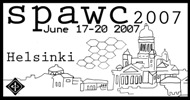Wireless Future: Connecting Everyone and Everything
Petteri Alinikula
Nokia Research Center
Advanced Network Calculus for Interference Functions
Holger Boche
Heinrich-Hertz Professor, Technical University of Berlin
The concept of interference function was originally proposed for the modelling of multiuser interference in wireless communication systems. Yet it has recently been shown that problems like network utility maximization, characterization of the feasible QoS regions in wireless networks, and interference coordination/management can also be analysed in a framework of general interference functions. In the talk the mathematical structure of these quite different technical problems will be analysed and structural properties of general, log-convex and convex/concave interference functions will be discussed. With these results it is for example possible to characterize the QoS conditions under which the feasible QoS region is a convex set. This on the other hand can be used to transform the optimal resource allocation problem into a convex optimization problem, which is very interesting for cross-layer optimization.
Wireless Communication Networks as Environmental Sensor NetworksHagit Messer
Tel Aviv University
Electromagnetic signals are known to be influenced by atmospheric conditions. Rapid growth of wireless communications and its global spread, bring about great opportunity for their use in environmental studies. Our research focuses on extracting the relevant information from wireless, and in particular cellular communication systems, to be used as environmental sensor networks (ESN).
In a recently published pioneer work (Messer et al., SCIENCE, 312 (5774): 713-713 MAY 5 2006) we have demonstrated that received signal level (RSL) measurements from fixed terrestrial line-of-sight microwave links, deployed by cellular operators, can be used to estimate space-time rainfall intensities. In this talk I will first focus on the application of using wireless communication networks measurements for estimation of rainfall intensities, demonstrating its superiority over traditional weather radar in terms of accuracy and its better spatial coverage than dedicated rain gauges. Then, we will review other opportunities and challenges in environmental monitoring from cellular networks, including: precipitation classification, fog monitoring, urban rain measurements, and the most ambitious future challenge - to use measurements from the power control protocols with the mobile phones (and not the microwave links) for precipitation monitoring.
Fundamental issues in Cognitive RadioSimon Haykin
McMaster University, Canada
Cognitive Radio is fast emerging as an exciting and multidisciplinary< subject, which has the potential for being a "disruptive technology", thereby making a significant difference to wireless communications. In this Plenary Lecture, I will address the following fundamental issues: The cognitive signal processing cycle, as viewed by the radio transceiver. The basic functional blocks of radio scene analysis, channel state estimation, feedback channel, and dynamic spectrum management and transmit power control. The role of stochastic games in the theory and design of a multiuser cognitive radio environment. The emergent behaviour of cognitive radio.
Wireless Networking with Secrecy ConstraintsLang Tong
Irwin and Joan Jacobs Professor in Engineering Cornell University, Ithaca, NY 14853
Wireless networks are vulnerable to intrusion and attack. Even the strongest encryption and authentication are not sufficient to protect the network. Because signal propagates in shared media, the very acts of transmission, easily detectable using simple devices, reveal crucial aspects of networking. For example, by listening the widely used RTS-CTS exchanges, an eavesdropper can guess the transmitter-receiver pair without decoding the content of the transmission. If eavesdropping sensors are geographically distributed in the network, a malicious attacker can obtain medium access control (MAC) and routing information and track messages propagating in the network, which allows the adversary to jam the network at a crucial time or launch a denial-of-service attack.
We present in this talk two related problems. The first is the detection of information flow where we address some of the following questions: Can a route be discovered by eavesdropping sensors? What are the fundamental limits of hiding the information flow in a multihop setup? What are the effective ways of detecting information flows when they are detectable? This problem is also related to the so-called stepping-stone detection. The second problem is on defending eavesdropping via randomized scheduling. Here we are interested in the achievable network flow under secrecy constraints.



